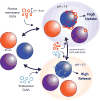Combinatorial Library Screening with Liposomes for Discovery of Membrane Active Peptides
- PMID: 28378995
- PMCID: PMC5901688
- DOI: 10.1021/acscombsci.6b00182
Combinatorial Library Screening with Liposomes for Discovery of Membrane Active Peptides
Abstract
Membrane active peptides (MAPs) represent a class of short biomolecules that have shown great promise in facilitating intracellular delivery without disrupting cellular plasma membranes. Yet their clinical application has been stalled by numerous factors: off-target delivery, a requirement for high local concentration near cells of interest, degradation en route to the target site, and in the case of cell-penetrating peptides, eventual entrapment in endolysosomal compartments. The current method of deriving MAPs from naturally occurring proteins has restricted the discovery of new peptides that may overcome these limitations. Here, we describe a new branch of assays featuring high-throughput functional screening capable of discovering new peptides with tailored cell uptake and endosomal escape capabilities. The one-bead-one-compound (OBOC) combinatorial method is used to screen libraries containing millions of potential MAPs for binding to synthetic liposomes, which can be adapted to mimic various aspects of limiting membranes. By incorporating unnatural and d-amino acids in the library, in addition to varying buffer conditions and liposome compositions, we have identified several new highly potent MAPs that improve on current standards and introduce motifs that were previously unknown or considered unsuitable. Since small variations in pH and lipid composition can be controlled during screening, peptides discovered using this methodology could aid researchers building drug delivery platforms with unique requirements, such as targeted intracellular localization.
Keywords: drug delivery platforms; endosomal escape capabilities; high-throughput; liposomes; membrane-active proteins; one-bead-one-compound.
Conflict of interest statement
The authors declare no competing financial interests.
Figures








References
-
- Lehner R, Wang X, Marsch S, Hunziker P. Intelligent nanomaterials for medicine: Carrier platforms and targeting strategies in the context of clinical application. Nanomed-Nanotechnol. 2013;9:742–757. - PubMed
-
- Liang W, W Lam JK. In: Molecular Regulation of Endocytosis. Ceresa B, editor. Chapter 17 InTech; 2012.
Publication types
MeSH terms
Substances
Grants and funding
LinkOut - more resources
Full Text Sources
Other Literature Sources
Research Materials

